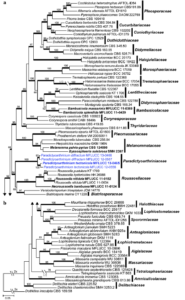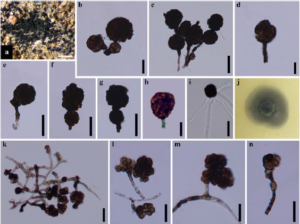Paradictyoarthrinium tectonicola Doilom & K.D.Hyde.
Index Fungorum number: IF550900, Facesoffungi number:FoF00315; Fig. 2
Etymology – In reference to the host Tectona, and cola meaning loving.
Holotypus – MFLU 14–0629.
Saprobic on dead stump of Tectona grandis L.f. Sexual morph Undetermined. Asexual morph Colonies on natural substrate, superficial, gregarious, scattered, black, powdery. Conidiophores up to 33 μm long, 1.5 – 3 μm diam., macronematous, erect to slightly curved, constrict at the septa, arising from hyphae. Conidiogenous cells blastic, integrated, terminal, determinate. Conidia (8–) 17 – 21 (–26) high × (8–) 16 – 19 (–22) μm (x̄ = 18 × 16 μm, n = 30), muriform, subglobose to ellipsoidal, brown to black, verrucose, solitary or developing in branched chains, with 1 – 3 short chains, very variable in size and shape; circular to irregular with a protruding basal cell; rounded to truncate at the base.
Culture characters – Ascospores germinating on PDA within 24 h. Germ tubes produced around conidia. Colonies on MEA reaching 18 – 28 and 26 – 35 mm diam. after 7 and 10 d in the dark at 25 °C respectively (av = 20 mm (7 d), 29 mm (10 d) n = 10), circular shape, superficial, flattened to effuse, velvety, dense, grey (26E1), entire edge. Mycelium 1.5 – 3.5 μm broad, partly superficial, partly immersed, pale brown to dark brown, septate, branched, verruculose. Chlamydospores reddish-brown. Conidiophores up to 30 μm long, 3–4 diam., arising from hyphae. Conidia (9–) 15 – 23 (–37) high × (9–) 14 – 18 (–35) μm (x̄ = 19 × 17 μm, n = 30), muriform, reddish-brown to dark brown.
Material examined – THAILAND, Chiang Rai Province, Mae Chan District, Kiu Tap Yang garden, on dead stem of Tectona grandis (Lamiaceae), 3 March 2013, M. Doilom (MFLU 14–0629, holotype), ex-type living culture, MFLUCC 13–0465, ICMP 20686. GenBank ITS: KP744456; LSU: KP744500; SSU: KP753961; ibid., MFLU 14-0630, living culture MFLUCC 12-0556. GenBank LSU: KP744499.
Notes – Paradictyoarthrinium tectonicola is introduced as second species of Paradictyoarthrinium. Two species can be distinguished as colonies of P. tectonicola are slower growing on MEA for at least 10 days than P. diffractum (Prabhugaonkar and Bhat 2011). Paradictyoarthrinium tectonicola and P. diffractum are very variable in size and shape of conidia, thus having no obvious different conidia dimensions. Nevertheless, phylogenetic analyses based on ITS sequence data can separate them at the species level. Isolates of P. tectonicola (MFLUCC 12–0556 and ex-type MFLUCC 13–0465) grouped separately from P. diffractum (MFLUCC 12–0557 and MFLUCC 13–0466) with strong MLBS (100 %) and PP (1.00) support in the combined LSU, SSU, TEF1 and RPB2 phylogeny (Fig. 1).

Fig. 1 Phylogram generated from Maximum likelihood (RAxML) analysis based on combined LSU, SSU, TEF1 and RPB2 sequence data of Pleosporales. Maximum likelihood bootstrap support values greater than 50 % are indicated above or below the nodes, and branches with Bayesian posterior probabilities greater than 0.95 are given in bold. The ex-types (reference strains) are in bold; the new isolates are in blue. The tree is rooted with Dothidea insculpta CBS 189.58.

Fig. 2 Paradictyoarthrinium tectonicola (holotype) a Colonies on host b Conidia with basal cells c–e Conidia with conidiogenous cells on host f, g Conidia with conidial chains i Germinating conidia j Culture onMEA after 1 week k – n Conidia with conidiophores on MEA. Scale bars: a = 500 μm, b, d, h = 10 μm, c, e-f, i, k – n = 20 μm.
